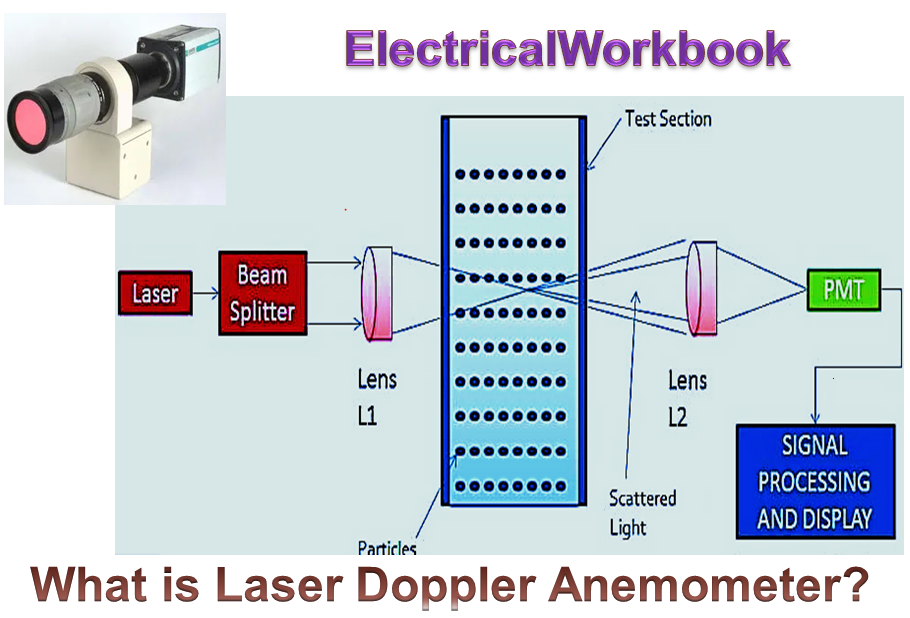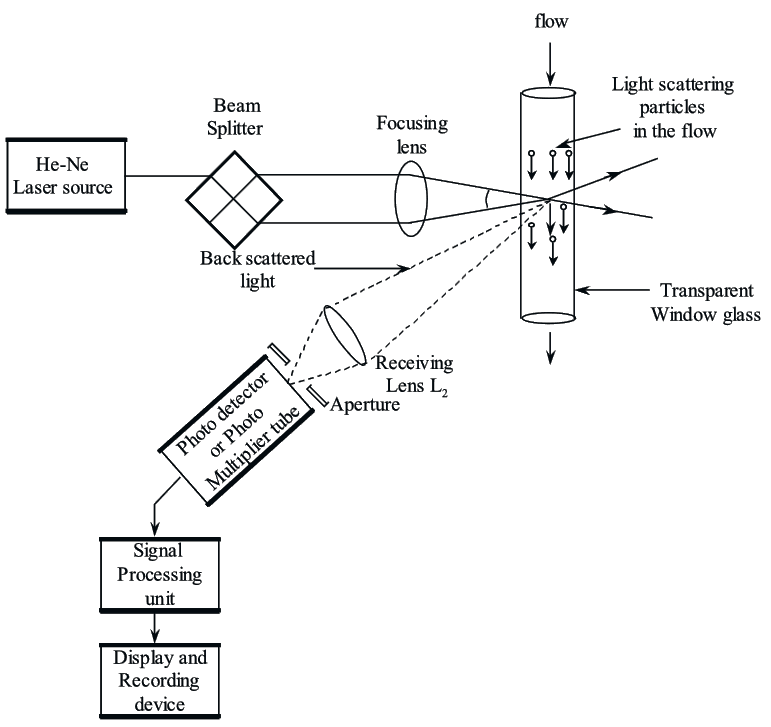
Working Principle of Laser Doppler Anemometer
Laser Doppler Anemometer or Laser Doppler velocimetry (LDV), works on the principle of Doppler effect. It states that whenever a laser beam passes through the moving fluid, frequency shift takes place in the light scattered by the small particles present in that fluid. This shift in the frequency of the beam is directly proportional to the velocity of the fluid flow.
Construction and Working of Laser Doppler Anemometer

Figure 1: Laser Doppler Anemometer
It consists of He-Ne laser source, beam splitter, focusing and receiving lenses, photo detector, signal processing, and recording circuit. The beam splitter can be an optical prism or rotating optical grating or half silvered minor. The beam splitter is placed at 45° to the laser beam. The schematic arrangement of a Laser Doppler Anemometer (dual beam) is illustrated in figure 1.
The laser beam from laser source passes through the beam splitter which splits the beam into two parts. These two parts of beam then passes to focusing lens L1 which focus the beam at a point in the flow stream where the velocity is to be determined. At this focal point the two parts of beam cross each other. Therefore an interference fringe is formed. This fringe pattern contains alternate areas of low and high intensity. If the flow stream containing tiny tracer particles such as microscopic dust or dust particles passes through the high intensity area, the particles scatter the light. Due to this frequency shift occurs in the scattered light. When this scattered light falls on the photodetector circuit which shows the varying electrical signal. The frequency of this signal is proportional to the rate at which the dust particles crosses the interference fringes. The spacing between the fringes can be expressed as,
\[\overline{\text{x}}\text{ }=\text{ }\frac{\lambda }{\text{2}}\text{sin}\left( \frac{\theta }{\text{2}} \right)\]
Where,
λ – Wavelength of laser beam
θ – Angle between two converging beams.
Assume that the tracer particles having velocity v equal to that of flow velocity pass across the fringes in perpendicular direction to the fringes then the detected signal would have Doppler shift in the frequency that is given by,
\[\Delta \text{f}=\text{ }\frac{\text{2v}}{\lambda }\text{sin}\left( \frac{\theta }{2} \right)\]
Where,
λ – Wavelength of the laser beam in the flow.
This is different from the wavelength of vacuum by a factor equal to the index of refraction.
\[\Delta \text{f}=\text{ }\frac{\text{2nv}}{{{\lambda }_{0}}}\text{sin}\left( \frac{\theta }{2} \right)\]
Where,
λ0 – Wavelength of laser in vacuum
n – Index of refraction of the fluid.
Advantages of Laser Doppler Anemometer
- This method does not disturbs the fluid flow.
- It does not require any calibration to determine the flow.
- It does not require any physical contact with the fluid whose flow rate is to be determined i.e., it is a non-contact type instrument
- Accuracy is very high (approximately ± 0.2%).
- It can be used to measure both liquid and gaseous flows.
Disadvantages of Laser Doppler Anemometer
- It is suited for the measurement of flow passing through transparent channel only.
- It is not suited for the flow of clean fluids.
- A skilled operator is required to use this instrument.
- Cost is very high.
Applications of Laser Doppler Anemometer
- It is used for the analysis of wind tunnels.
- It is employed for blood flow measurement.
- Applicable for sensing of wind velocity.
- Used in the field of combustion.
- It can be used for both gas and liquid flow studies.
- It is used in both research and industrial applications.